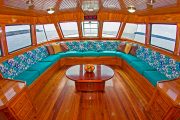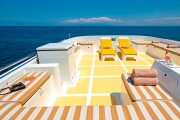Day 1 – WEDNESDAY:Baltra / Bachas Beach
A US$20 per person transit card is payable on departure at Quito Airport and a US$100 per person national park entry fee is payable on arrival on the islands. Please have cash on hand for these transactions as credit cards can be time consuming.
On arrival in the Galapagos we are met in the arrivals hall and then transferred to our boat, the Daphne, anchored a short distance away. Once on board we’ll be assigned our cabins, meet the crew members and get to know our naturalist guide and fellow travellers over a delicious lunch.
The sandy, white beaches of Las Bachas on the north shore of Santa Cruz Island are a nesting site for the Pacific green turtle, and marine iguanas are also commonly seen. The sand here is particularly white and soft as it is made of decomposed coral. The rocks provide great snorkelling and are the perfect habitat for the Sally Lightfoot crabs, which are plentiful on the island. A saltwater lagoon near to the beach is home to flamingo and whimbrel, and also look out for great blue herons. Remnants of a floating pier can still be sighted, and it is a testimony to the US presence in the Galapagos during World War II.










 WhatsApp us
WhatsApp us